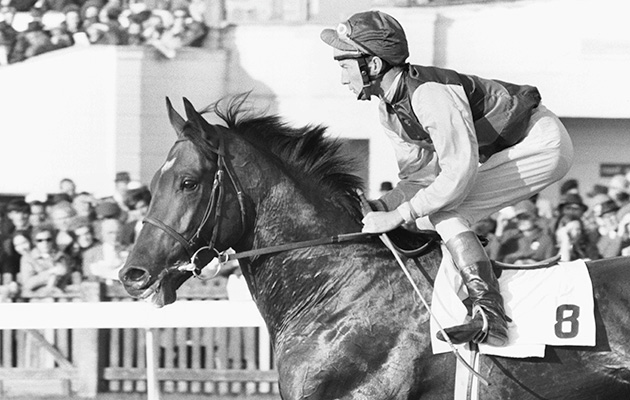The Flat jockey’s killer instinct, unique style and tremendous race record secured him a place with the all-time greats – despite a chequered personal life, writes Julian Muscat
It was a sight as distinctive as it was reassuring. When Lester Piggott was still standing bolt upright as jockeys around him crouched low into their saddles, his legion of backers would start counting their money. Never mind that there might have been another furlong left to run. Piggott’s silhouette in cruise control always told its own story. Then he would shift his weight imperceptibly and his mount, duly prompted, would gallop away to victory.
You couldn’t mistake the “Long Fellow” for anyone else. Uncommonly tall for a Flat jockey at more than 5ft 7in, Piggott developed a riding style that was all his own. He had an aquiline presence: perched high above the withers, motionless and unblinking, poised to strike with deadly effect.
That’s why Piggott held the nation in thrall, from owners and trainers right through to housewives having their annual flutter on the Derby – a race Piggott won a record nine times.
{"content":"PHA+Tm8gb3RoZXIgZXF1ZXN0cmlhbiBwdXJzdWl0IGlzIGFzIGltbWVyc2VkIGluIGJldHRpbmcgYXMgaG9yc2UgcmFjaW5nLiBJdCB3YXMgYW4gYWN0IG9mIGJsaW5kIGZhaXRoIGZvciBwdW50ZXJzIHRvIGVudHJ1c3QgdGhlaXIgaGFyZC1lYXJuZWQgdG8gdGhlIG1hbiBpbiB0aGUgc2FkZGxlLiBCdXQgdGhlbiwgUGlnZ290dCBhbmQgaGlzIGZhbnMgd2VyZSB1bml0ZWQgaW4gYSBzaW5nbGUgY2F1c2UuIFdpbm5pbmcgd2FzIGFsbCB0aGF0IG1hdHRlcmVkLjwvcD4KPHA+U28gbXVjaCBzbyB0aGF0IFBpZ2dvdHTigJlzIGdpbGRlZCBjYXJlZXIgd291bGQgYWxzbyB0cmF3bCB0aGUgZGVwdGhzLiBEaXNkYWluZnVsIG9mIGF1dGhvcml0eSBhbmQgaW1wZXJ2aW91cyB0byBhbnl0aGluZyBpbiBoaXMgcGF0aCwgaGUgd291bGQgcGF5IGEgaGVhdnkgcHJpY2UuIEluIDE5ODcsIGhlIHNlcnZlZCB0aGUgZmlyc3Qgb2YgYSB0aHJlZSB5ZWFyIGphaWwgc2VudGVuY2UgZm9yIHRheCBldmFzaW9uIGFmdGVyIGhlIHdhcyBsZXNzIHRoYW4gZm9ydGhjb21pbmcgd2l0aCBIZXIgTWFqZXN0eeKAmXMgUmV2ZW51ZSBhbmQgQ3VzdG9tcywgcHJvbXB0aW5nIEhlciBNYWplc3R5IHRvIHN0cmlwIGhpbSBvZiB0aGUgT0JFIGhl4oCZZCBiZWVuIGF3YXJkZWQgMTIgeWVhcnMgZWFybGllci48L3A+CjxwPjxkaXYgY2xhc3M9ImFkLWNvbnRhaW5lciBhZC1jb250YWluZXItLW1vYmlsZSI+PGRpdiBpZD0icG9zdC1pbmxpbmUtMiIgY2xhc3M9ImlwYy1hZHZlcnQiPjwvZGl2PjwvZGl2PjxzZWN0aW9uIGlkPSJlbWJlZF9jb2RlLTMxIiBjbGFzcz0iaGlkZGVuLW1kIGhpZGRlbi1sZyBzLWNvbnRhaW5lciBzdGlja3ktYW5jaG9yIGhpZGUtd2lkZ2V0LXRpdGxlIHdpZGdldF9lbWJlZF9jb2RlIHByZW1pdW1faW5saW5lXzIiPjxzZWN0aW9uIGNsYXNzPSJzLWNvbnRhaW5lciBsaXN0aW5nLS1zaW5nbGUgbGlzdGluZy0tc2luZ2xlLXNoYXJldGhyb3VnaCBpbWFnZS1hc3BlY3QtbGFuZHNjYXBlIGRlZmF1bHQgc2hhcmV0aHJvdWdoLWFkIHNoYXJldGhyb3VnaC1hZC1oaWRkZW4iPg0KICA8ZGl2IGNsYXNzPSJzLWNvbnRhaW5lcl9faW5uZXIiPg0KICAgIDx1bD4NCiAgICAgIDxsaSBpZD0ibmF0aXZlLWNvbnRlbnQtbW9iaWxlIiBjbGFzcz0ibGlzdGluZy1pdGVtIj4NCiAgICAgIDwvbGk+DQogICAgPC91bD4NCiAgPC9kaXY+DQo8L3NlY3Rpb24+PC9zZWN0aW9uPjwvcD4KPHA+VGhhdCByb3lhbCBjZW5zdXJlIHRvcm1lbnRzIGhpbSB0byB0aGlzIGRheS4gQXMgdGhlIGxhdGUgU2lyIFBldGVyIE\/igJlTdWxsZXZhbiwgb25lIG9mIFBpZ2dvdHTigJlzIGNsb3Nlc3QgY29uZmlkYW50ZXMsIHRvbGQgbWUgd2hlbiBkaXNjdXNzaW5nIHRoZSBqb2NrZXkgaW4gMjAxMzog4oCcR29pbmcgdG8gcHJpc29uIHJlYWxseSBjaGFuZ2VkIExlc3RlciBiZWNhdXNlIGl0IHdhcyBsaWtlIGltcHJpc29uaW5nIGEgd2lsZCBiaXJkIGluIGEgY2FnZS4gSGUgY29wZWQgd2l0aCB0aGF0LCBidXQgd2hhdCByZWFsbHkgdXBzZXQgaGltIHdhcyBsb3NpbmcgaGlzIE9CRS4gSGUgZmVsdCB0aGUgdGF4IG1hdHRlciB3YXNu4oCZdCBhdCBhbGwgY29ubmVjdGVkIHRvIGhpcyBvdGhlciBhY2hpZXZlbWVudHMu4oCdPC9wPgo8cD5UaGF0IHNvcnJ5IGNoYXB0ZXIgd2FzIGFzIHNhZCBhcyBpdCB3YXMgYWxtb3N0IGluZXZpdGFibGUuIE\/igJlTdWxsZXZhbuKAmXMg4oCcd2lsZCBiaXJk4oCdIGFuYWxvZ3kgaXMgYXB0IGZvciBhIG1hbiB3aG8gd2FzIGludGVuc2VseSBncm9vbWVkIGZvciBzYWRkbGUgbGlmZSBmcm9tIHRoZSBkYXkgaGUgd2FzIGJvcm4uIEl0IHdvdWxkIGJlYXIgZnJ1aXQsIGV2ZW4gaWYgaGlzIHVwYnJpbmdpbmcgd2FzIHdvZWZ1bGx5IHNob3J0IG9mIGh1bWFuIGVtcGF0aHkuPC9wPgo8aDM+QSBsYW5kc2xpZGUgcmVjb3JkPC9oMz4KPHA+TW9zdCByZWNvcmRzIGluIHJhY2luZyBhcmUgYnJva2VuIGJlY2F1c2UgdGhlIGZpeHR1cmUgbGlzdCBrZWVwcyBleHBhbmRpbmcsIGluIHRoZSBwcm9jZXNzIHByb3ZpZGluZyBqb2NrZXlzIHdpdGggaW5jcmVhc2VkIG9wcG9ydHVuaXRpZXMuIFlldCBCcml0YWlu4oCZcyBmaXZlIENsYXNzaWMgcmFjZXMgaGF2ZSBlbmR1cmVkIGZvciBtb3JlIHRoYW4gMjAwIHllYXJzLiBQaWdnb3R04oCZcyBoYXVsIG9mIDMwIHJlbWFpbnMgYSBsYW5kc2xpZGUgcmVjb3JkLiBGdXJ0aGVybW9yZSwgUGlnZ290dCB3b24gMTQgb2YgdGhlIDE1IENsYXNzaWNzIGluIEJyaXRhaW4sIElyZWxhbmQgYW5kIEZyYW5jZS4gTm8gb3RoZXIgam9ja2V5IGhhcyBjb21lIGNsb3NlLjwvcD4KPGRpdiBjbGFzcz0iYWQtY29udGFpbmVyIGFkLWNvbnRhaW5lci0tbW9iaWxlIj48ZGl2IGlkPSJwb3N0LWlubGluZS0zIiBjbGFzcz0iaXBjLWFkdmVydCI+PC9kaXY+PC9kaXY+CjxwPkhpcyByZWNvcmQgYWxvbmUgc3BlYWtzIHZvbHVtZXMsIGFsdGhvdWdoIHJpZGluZyBwcm93ZXNzIHdhcyBvbmx5IHBhcnQgb2YgdGhlIGVxdWF0aW9uLiBQaWdnb3R04oCZcyBwdWJsaWMgcGVyc29uYSDigJMgZGlmZmlkZW50IGFuZCB0cnVjdWxlbnQsIHVuY29tbXVuaWNhdGl2ZSBhbmQgY3VybXVkZ2Vvbmx5IOKAkyB3YXMgYSBsZWdhY3kgb2YgdGhlIGJ1cm5pbmcgYW1iaXRpb24gaGlzIG1vdGhlciBmb3N0ZXJlZCBpbiBoaW0uPC9wPgo8cD5JcmlzIFJpY2thYnkgaGFpbGVkIGZyb20gYSBmYW1pbHkgc3RlZXBlZCBpbiBqb2NrZXlzLiDigJxJdCB3YXMgYWxsIGRvd24gdG8gdGhlIHdheSBMZXN0ZXIgd2FzIGJyb3VnaHQgdXAsIHdpdGggaGlzIG1vdGhlciBwdXR0aW5nIHRoZSBicmFrZXMgb24gYWxsIHRoZSB0aW1lLOKAnSBP4oCZU3VsbGV2YW4gc2FpZC4g4oCcQXMgYSBSaWNrYWJ5IHNoZSBoYWQgc2VlbiBqb2NrcyBmYWxsIGJ5IHRoZSB3YXlzaWRlIGFuZCB0aGVpciBleHRyYXZhZ2FudCBleGNlc3Nlcy4gU2hlIHdhcyBkZXRlcm1pbmVkIHRoZSBzYW1lIHdvdWxkbuKAmXQgaGFwcGVuIHRvIGhlciBzb24u4oCdPC9wPgo8ZGl2IGNsYXNzPSJhZC1jb250YWluZXIgYWQtY29udGFpbmVyLS1tb2JpbGUiPjxkaXYgaWQ9InBvc3QtaW5saW5lLTQiIGNsYXNzPSJpcGMtYWR2ZXJ0Ij48L2Rpdj48L2Rpdj4KPHA+T+KAmVN1bGxldmFu4oCZcyB2aWV3IGlzIGNvcnJvYm9yYXRlZCBieSBKaW1teSBMaW5kbGV5LCBtdWNoIG9mIHdob3NlIHJpZGluZyBjYXJlZXIgb3ZlcmxhcHBlZCB3aXRoIFBpZ2dvdHTigJlzLiDigJxGcm9tIGEgdmVyeSB5b3VuZyBhZ2UsIExlc3RlcuKAmXMgbW90aGVyIGNvdWxkIHNlZSBoZSB3YXMgZ29pbmcgdG8gYmVjb21lIHF1aXRlIHRhbGws4oCdIGhlIHNheXMuPC9wPgo8cD7igJxTaGUgcmFuIG11Y2ggb2YgTGVzdGVy4oCZcyBlYXJseSBsaWZlLCBlc3BlY2lhbGx5IGhpcyBkaWV0LOKAnSBMaW5kbGV5IGNvbnRpbnVlcy4g4oCcSSB0aGluayBoZSB3b3VsZCBoYXZlIGJlY29tZSB0b28gaGVhdnkgYW5kIGxvc3QgaW50ZXJlc3Qgd2VyZSBpdCBub3QgZm9yIGhpcyBtb3RoZXIuIEhpcyBsaWZlIHdhcyB2ZXJ5IHJlc3RyaWN0ZWQ7IGhlIG5ldmVyIGhhZCBhIGNoaWxkaG9vZC4gTm90aGluZyBldmVyIGNhbWUgaW50byBoaXMgbGlmZSBleGNlcHQgaG9yc2VzLuKAnTwvcD4KPGRpdiBjbGFzcz0iYWQtY29udGFpbmVyIGFkLWNvbnRhaW5lci0tbW9iaWxlIj48ZGl2IGlkPSJwb3N0LWlubGluZS01IiBjbGFzcz0iaXBjLWFkdmVydCI+PC9kaXY+PC9kaXY+CjxwPk5vciB3YXMgaGlzIGZhdGhlciBLZWl0aCwgYSBqb2NrZXktdHVybmVkLXRyYWluZXIsIGFueSBzb3J0IG9mIG1pdGlnYXRpbmcgaW5mbHVlbmNlLiBRdWl0ZSB0aGUgb3Bwb3NpdGUsIGluIGZhY3QuPC9wPgo8cD7igJxLZWl0aCB3YXMgYWJzb2x1dGVseSB0ZXJyaWZpZWQgdGhlIGZsYW1lIFtpbiBQaWdnb3R0XSB3b3VsZCBiZSBleHRpbmd1aXNoZWQs4oCdIE\/igJlTdWxsZXZhbiBzYWlkLiDigJxXaGVuIExlc3RlciByb2RlIG92ZXIgaHVyZGxlcyBpbiBoaXMgeW91dGgsIEtlaXRoIGVuY291cmFnZWQgaGltIHRvIHB1dCBvdGhlciBqb2NrZXlzIHRocm91Z2ggdGhlIHdpbmdzLjwvcD4KPHA+4oCcSWYgS2VpdGggd2FzIGNvbWluZyB0byB0aGUgbGFzdCBpbiBhIGh1cmRsZSByYWNlIGFuZCB3YXMgbHlpbmcgMTR0aCBvZiAxNSwgaGXigJlkIHB1dCB0aGUgam9ja2V5IGJlaGluZCBoaW0gdGhyb3VnaCB0aGUgd2luZ3MgYXMgYSBtYXR0ZXIgb2YgY291cnNlLiBLZWl0aCB3YXMgYSBoYXJkIG1hbi4gSGUgd2FudGVkIHRvIGJyaW5nIHVwIGEgaGFyZCBzb24gdG8gZG8gdGhlIGpvYi7igJ08L3A+CjxwPkJldHdlZW4gdGhlbSwgUGlnZ290dOKAmXMgcGFyZW50cyBpbmNsaW5lZCB0byBvdmVya2lsbCBpbiB0aGVpciB0dXRvcmluZy4gVGhlIGZhY3QgdGhhdCBQaWdnb3R0IHdhcyBhbiB1bmNvbW11bmljYXRpdmUgY2hpbGQgd2FzIG5vdCBlbnRpcmVseSBkb3duIHRvIHBhcnRpYWwgZGVhZm5lc3MgaW4gb25lIGVhciBhbmQgYSBzbGlnaHQgc3BlZWNoIGltcGVkaW1lbnQuPC9wPgo8cD5UaGlzLCB0aGVuLCB3YXMgdGhlIGJhY2tzdG9yeSB0byBhIG1hbiB3aG9zZSBydXRobGVzcyBleHBsb2l0YXRpb24gb2YgaGlzIGdpZnRzIHdvdWxkIHNlZSBoaW0gcmV3cml0ZSB0aGUgcHJldmFpbGluZyBtYXN0ZXIvc2VydmFudCByZWxhdGlvbnNoaXAgYmV0d2VlbiB0cmFpbmVycyBhbmQgam9ja2V5cy4gSXQgd2FzIGEgZGV0YWlsIHRoYXQgcmVzb25hdGVkIHdpdGggYmx1ZS1jb2xsYXIgcHVudGVyczogaGUgd2FzIHRoZWlyIGNoYW1waW9uLCBhIG1hbiBpbiBmZWFyIG9mIG5vYm9keSwgbGVhc3Qgb2YgYWxsIGNydXN0eSByYWNlY291cnNlIHN0ZXdhcmRzLCBpbiBhIGNhcmVlciB0aGF0IHNwYW5uZWQgZml2ZSBkZWNhZGVzLjwvcD4KPGgzPkEgcm91Z2ggc2Nob29sPC9oMz4KPHA+SGUgcm9kZSBoaXMgZmlyc3Qgd2lubmVyIHdoZW4gaGUgd2FzIDEyLiBTaXggeWVhcnMgb24gYW5kIGhl4oCZZCB3b24gdGhlIGZpcnN0IG9mIGhpcyBuaW5lIERlcmJ5cyBhYm9hcmQgTmV2ZXIgU2F5IERpZSwgaW4gMTk1NC4gQnkgdGhlbiwgYWdlZCAxOCwgaGUgd2FzIGFscmVhZHkgYSB3ZWlnaGluZy1yb29tIG1haW5zdGF5LCByaWRpbmcgYXQgYSB0aW1lIHdoZW4gcGF0cm9sIGNhbWVyYXMgbW9uaXRvcmluZyB0aGUgYWN0aW9uIGRpZCBub3QgZXhpc3QuPC9wPgo8cD5JbiB0aG9zZSBkYXlzLCByYWNlLXJpZGluZyB3YXMgYSByb3VnaCBzY2hvb2wsIG1vcmUgYWtpbiB0byB0aGUgV2lsZCBXZXN0LiBBbmQgdGhlIGxvbmVyIHdpdGggYSBmYWNlIG9mIHN0b25lIHdhcyB0aGUgZGVhZGxpZXN0IGd1bnNsaW5nZXIgaW4gdG93bi48L3A+CjxwPuKAnEJhY2sgdGhlbiwgTGVzdGVyIHdvdWxkIHRyeSB0byB3aW4gYXQgYWxsIGNvc3RzLOKAnSBzYXlzIEpvZSBNZXJjZXIsIGFub3RoZXIgY29udGVtcG9yYXJ5IG9mIFBpZ2dvdHQgd2hvIHdhcyBjaGFtcGlvbiBqb2NrZXkgaW4gMTk3OS4g4oCcV2hlbiBoZSB3YXMgYW4gYXBwcmVudGljZSwgdGhlIHNlbmlvciBndXlzIGdvdCB2ZXJ5IHVwc2V0IGJlY2F1c2UgaGUgc2hvd2VkIHRoZW0gbm8gcmVzcGVjdC4gSGUgZmlsbGVkIGV2ZXJ5IGhvbGUsIGRpZCBldmVyeXRoaW5nIGhlIHNob3VsZG7igJl0IGRvLuKAnTwvcD4KPHA+UGlnZ290dOKAmXMgcmVwZWF0ZWQgYWN0cyBvZiBkYXJpbmcgY2FtZSB0byBhIGhlYWQgYXQgUm95YWwgQXNjb3QgdHdvIHdlZWtzIGFmdGVyIE5ldmVyIFNheSBEaWXigJlzIERlcmJ5IHRyaXVtcGguIFJpZGluZyB0aGUgc2FtZSBob3JzZSwgaGUgd2FzIGFkanVkZ2VkIHRvIGhhdmUgY2F1c2VkIHNlcmlvdXMgaW50ZXJmZXJlbmNlIGFmdGVyIFNpciBHb3Jkb24gUmljaGFyZHMsIHRoZSBkb3llbiBhbW9uZyBqb2NrZXlzIHdob+KAmWQgYmVlbiBrbmlnaHRlZCB0aGUgcHJldmlvdXMgeWVhciwgcGlubmVkIHRoZSBibGFtZSBvbiBQaWdnb3R0IGR1cmluZyBhIHN0ZXdhcmRz4oCZIGlucXVpcnkuPC9wPgo8cD5JbiBjb25zZXF1ZW5jZSwgUGlnZ290dCB3YXMgYmFubmVkIGluZGVmaW5pdGVseSBhbmQgbWFkZSB0byB3b3JrIGF3YXkgZnJvbSB0aGUgc3RhYmxlIG9mIGhpcyBmYXRoZXIsIHdob20gVGhlIEpvY2tleSBDbHViIHBlcmNlaXZlZCBhcyBhIGJhZCBpbmZsdWVuY2UuIFNvb24gYWZ0ZXIgUmljaGFyZHMgcmV0aXJlZCwgdGhlIHN0ZXdhcmRzIHN1Z2dlc3RlZCBQaWdnb3R0IHNob3VsZCByZWFwcGx5IGZvciBoaXMgbGljZW5jZSBhbmQgaGUgcmV0dXJuZWQgYWZ0ZXIgYSAxMi13ZWVrIGhpYXR1cyB3aXRoIHR5cGljYWwgZGVmaWFuY2UuIEhlIHJvZGUgYSB3aW5uZXIgb24gaGlzIGNvbWViYWNrIHJpZGUgYXQgTmV3bWFya2V0LjwvcD4KPHA+SW4gTWVyY2Vy4oCZcyBleWUsIHRoYXQgZm91ci1tb250aCBzdGludCBhdCBOZXdtYXJrZXQgd2l0aCBoaXMgdW5jbGUsIEphY2sgSmFydmlzLCBoYWQgdGhlIGRlc2lyZWQgZWZmZWN0LiDigJxIZSB3YXMgYSBiaXQgb2YgYSByYXNjYWwsIGJ1dCBhZnRlciB0aGF0LCBoZSBzZWVtZWQgdG8gZ3JvdyBvdXQgb2YgaXQs4oCdIE1lcmNlciBzYXlzLiDigJxJdCBkaWQgaGltIGdvb2QsIGJ1dCBoZSB3YXMgc3RpbGwgYSB0b3VnaCBjb29raWUu4oCdPC9wPgo8cD5JZiBhbnl0aGluZywgdGhlIGV4cGxvc2l2ZSB0YWxlbnQgb2YgYSBtYW4gYm9ybiBvbiBHdXkgRmF3a2VzIE5pZ2h0IOKAkyA1IE5vdmVtYmVyIDE5MzUg4oCTIHdhcyBoZWlnaHRlbmVkIGJ5IGhpcyBlbmZvcmNlZCBhYnNlbmNlLiBIZSBtYXkgaGF2ZSByaWRkZW4gbGVzcyBhZ2dyZXNzaXZlbHksIGJ1dCBoZSB3YXMgc3RpbGwgY29uc3VtZWQgYnkgZGVzaXJlLiBIZSB3YXMgYWxzbyBjb3VydGVkIGJ5IE5vZWwgTXVybGVzcywgd2hvIHRyYWluZWQgYXQgV2FycmVuIFBsYWNlIFN0YWJsZXMsIGluIE5ld21hcmtldC48L3A+CjxwPlRoZWlycyB3YXMgYW4gYWxsaWFuY2UgdGhhdCB3b3VsZCBzcGFuIDEyIHNlYXNvbnMgcHVuY3R1YXRlZCBieSBhIGhlcmQgb2Ygc2lnbmF0dXJlIGhvcnNlcy4gQ3JlcGVsbG8sIHNvbWV0aW1lcyBjaXRlZCBieSBQaWdnb3R0IGFzIHRoZSBiZXN0IGhvcnNlIGhlIHJvZGUsIHdvbiB0aGUgMjAwMCBHdWluZWFzIGFuZCBEZXJieSBpbiAxOTU3LiBJbiB0aGF0IHllYXIsIFBpZ2dvdHQgYWxzbyB3b24gdGhlIE9ha3MgYWJvYXJkIFRoZSBRdWVlbuKAmXMgQ2Fycm96emEuPC9wPgo8cD5ZZXQgdGhlIGhvcnNlIHRoYXQgZGVmaW5lZCB0aGUgUGlnZ290dC9NdXJsZXNzIGF4aXMgd2FzIHRoZSBkYXBwbGVkIGdyZXkgZmlsbHksIFBldGl0ZSBFdG9pbGUuIEEgdGhyZWUteWVhci1vbGQgaW4gMTk1OSwgUGV0aXRlIEV0b2lsZSB3b24gYWxsIHNpeCBvZiBoZXIgc3RhcnRzIHRoYXQgc2Vhc29uLCBhbW9uZyB0aGVtIHRoZSAxMDAwIEd1aW5lYXMgYW5kIE9ha3MsIHRvZ2V0aGVyIHdpdGggdGhlIFlvcmtzaGlyZSBPYWtzLCBTdXNzZXggU3Rha2VzIGFuZCBDaGFtcGlvbiBTdGFrZXMuIERvdWJ0bGVzcyBhYmV0dGVkIGJ5IFBpZ2dvdHQgb24gaGVyIGJhY2ssIHNoZSBidWlsdCB1cCBhIGRldm90ZWQgcHVibGljIGZvbGxvd2luZy4gQWxsIG9mIHdoaWNoIHNlcnZlZCB0byByZW5kZXIgdGhlIDE5NjAgS2luZyBHZW9yZ2UgVkkgYW5kIFF1ZWVuIEVsaXphYmV0aCBTdGFrZXMgdGhlIG1vc3QgY29udGVudGlvdXMgb2YgcmFjZXMuIEl0IHNhdyB0aGUgc2V0dGxpbmcgb2Ygc29tZSBwcml2YXRlIGZldWRzIGFtb25nIGpvY2tleXMuIFBpZ2dvdHQgd2FzIHRoZSB2aWN0aW0uPC9wPgo8cD5CZXR3ZWVuIHRoZW0sIFNjb2JpZSBCcmVhc2xleSBhbmQgR2VvZmYgTGV3aXMgZW5zdXJlZCBQaWdnb3R0IGFuZCBQZXRpdGUgRXRvaWxlIGhhZCBubyByYWNpbmcgcm9vbSB0aHJvdWdob3V0IHRoZSByYWNlLCBpbiB3aGljaCBBZ2dyZXNzb3IsIHJpZGRlbiBieSBKaW1teSBMaW5kbGV5LCBtYWRlIHRoZSBydW5uaW5nIG9uIHJhaW4gc29mdGVuZWQgZ3JvdW5kIHRoYXQgd2FzIG5vdCB0byBQZXRpdGUgRXRvaWxl4oCZcyBsaWtpbmcuPC9wPgo8cD7igJxTY29iaWUgYW5kIEdlb2ZmIHdlcmUgZ3JlYXQgbWF0ZXMs4oCdIExpbmRsZXkgcmVsYXRlcy4g4oCcVGhleSBib3RoIGhhZCB0aGUgbmVlZGxlIHdpdGggTGVzdGVyLCB3aG\/igJlkIGRvbmUgc29tZXRoaW5nIHRvIHVwc2V0IHRoZW0uIEluIHRoZSByYWNlLCB0aGV5IGdhdmUgTGVzdGVyIG5vIHF1YXJ0ZXIgYW5kIEkgcnVtYmxlZCB0aGlzIGFzIEkgcm9kZSBhbG9uZyBvdXQgaW4gZnJvbnQuPC9wPgo8cD7igJxJIGhlYXJkIHNob3V0aW5nIGJlaGluZCBtZSBhcyB3ZSB3ZW50IGludG8gdGhlIGhvbWUgdHVybizigJ0gTGluZGxleSBjb250aW51ZXMuIOKAnEkgc2Vuc2VkIHRyb3VibGUgc28gSSBraWNrZWQgYXMgaGFyZCBhcyBJIGNvdWxkLiBBZ2dyZXNzb3Igd2FzIGEgZ29vZCBzdGF5ZXIgYW5kIHRoZSBhZHZhbnRhZ2UgSSBwb2FjaGVkIHNhdyBtZSBob21lIGFmdGVyIExlc3RlciBoYWQgYmVjb21lIHRyYXBwZWQgb24gdGhlIGluc2lkZS7igJ08L3A+CjxwPlBpZ2dvdHQgd2FzIHJvdW5kbHkgc2xhdGVkIGZvciBoaXMgcmlkZSBhZnRlciBQZXRpdGUgRXRvaWxlIGZpbmlzaGVkIHNlY29uZCBhdCBwcm9oaWJpdGl2ZSBvZGRzIG9mIDIvNS4g4oCcVG8gYmUgZmFpciB0byBoaW0sIGhlIG5ldmVyIHNhaWQgYSB3b3JkIGFib3V0IGl0LOKAnSBMaW5kbGV5IHJlY2FsbHMuIOKAnE5vdCBhIHNpbmdsZSB3b3JkIG9mIGNvbXBsYWludC7igJ08L3A+CjxwPk9uIHRoYXQgZGF5LCBQaWdnb3R0IHJlYXBlZCB3aGF0IGhlIHNvd2VkLiBEZXNwaXRlIGhpcyBsaW5rcyB3aXRoIE11cmxlc3MgaGUgcm9kZSBmb3IgYSBzcGF0ZSBvZiBvdGhlciB0cmFpbmVycywgb2Z0ZW4gZGlzbG9kZ2luZyBvdGhlciBqb2NrZXlzIGZyb20gcmVndWxhciBtb3VudHMgb24gYmlnIGRheXMuPC9wPgo8cD7igJxIZSBiZWNhbWUgdGhlIHJ1dGhsZXNzIGtpbGxlciB0aGF0IGhlIHdhcywgdGFraW5nIHJpZGVzIGZyb20gZXZlcnlib2R5LOKAnSBzYXlzIFN0ZXZlIENhdXRoZW4sIHRoZSBjcmFjayBBbWVyaWNhbiBqb2NrZXkgd2hvIGNhbWUgdG8gcmlkZSBpbiBCcml0YWluLCBhZ2VkIDE3LCBpbiAxOTc4LiDigJxJZiBhIHRyYWluZXIgZGlkbuKAmXQgd2FudCBoaW0gb24gYSBob3JzZSwgaGXigJlkIGNhbGwgdGhlIGhvcnNl4oCZcyBvd25lci48L3A+CjxwPuKAnEhlIGNvdWxkIGdldCBhd2F5IHdpdGggaXQgYmVjYXVzZSBoZSB3YXMgc28gcGhlbm9tZW5hbGx5IGdpZnRlZC4gVGhleSB1c2VkIHRvIGNhbGwgaGltIOKAmEpD4oCZIGluIHRoZSB3ZWlnaGluZyByb29tLiBIZSBjb3VsZCB3YWxrIG9uIHdhdGVyOyBoZSBjb3VsZCBnZXQgcGVvcGxlIGVhdGluZyBvdXQgb2YgaGlzIGhhbmRzLuKAnTwvcD4KPHA+VGhhdCB3YXMgUGlnZ290dCBpbiBhIG51dHNoZWxsLiBKdXN0IGFib3V0IGV2ZXJ5IG90aGVyIGpvY2tleSBsaXZlZCBpbiBkYWlseSBkcmVhZCB0aGF0IFBpZ2dvdHQgd291bGQg4oCcam9jayB0aGVtIG9mZuKAnSB0aGVpciBiZXN0IHJpZGVzLiBBcyBWaW5jZW50IE\/igJlCcmllbiwgdGhlIHRyYWluZXIgZm9yIHdob20gUGlnZ290dCByb2RlIGEgc3VjY2Vzc2lvbiBvZiBncmVhdCBob3JzZXMsIHJlcGxpZWQgd2hlbiBhc2tlZCBhYm91dCB0aGUgbWVyaXQgb2YgaGF2aW5nIFBpZ2dvdHQgcmlkaW5nIGZvciB5b3U6IOKAnEl0IG1lYW5zIGhlIGlzbuKAmXQgcmlkaW5nIGFnYWluc3QgeW91LuKAnTwvcD4KPHA+Q2F1dGhlbiBjaXRlcyBzZXZlcmFsIGZhY2V0cyB0byBQaWdnb3R04oCZcyBhbGwtcm91bmQgYnJpbGxpYW5jZS4g4oCcVGhlcmXigJlzIG5vIHF1ZXN0aW9uIGhlIHdhcyBhbiBleGNlcHRpb25hbCBob3JzZW1hbiB0aHJvdWdoIGFuZCB0aHJvdWdoLOKAnSBoZSBzYXlzLCDigJxidXQgdGhhdOKAmXMgb25seSBwYXJ0IG9mIGl0LiBIZSB3YXMgdGhlIGJlc3QgYXQgZ2V0dGluZyBvbiB0aGUgYmVzdCBob3JzZSwgYW5kIHdoZW4gaGUgZGlkLCBoZSByb2RlIHRoZW0gd2l0aCBncmVhdCBjb25maWRlbmNlLjwvcD4KPHA+4oCcSGUgYWxzbyBrbmV3IHRoZSBzdHJlbmd0aHMgYW5kIHdlYWtuZXNzZXMgb2YgdGhlIGhvcnNlcyBoZSB3YXMgcmlkaW5nIGFnYWluc3QsIGFuZCBoZSBoYWQgdGhlIGtpbGxlciBpbnN0aW5jdCBhbmQgcmF3IGRlc2lyZS4gRGVzaXJlIGlzIHByb2JhYmx5IHRoZSBtb3N0IGltcG9ydGFudCB0aGluZy4gSXQgZG9lc27igJl0IG5lY2Vzc2FyaWx5IG1ha2UgeW91IGhhcHB5LCBidXQgaXQgbWFrZXMgeW91IHRoZSBtb3N0IHN1Y2Nlc3NmdWwuIEZvciBMZXN0ZXIsIHRoYXQgd2FzIGV2ZXJ5dGhpbmcu4oCdPC9wPgo8aDM+VGhlIGNvbGQgZXllIG9mIGFuIGFzc2Fzc2luPC9oMz4KPHA+VGhlbiB0aGVyZSB3YXMgUGlnZ290dOKAmXMgaW50aW1pZGF0aW5nIGF1cmEuIFRoaXMgd2FzIGFtcGxpZmllZCB2aXZpZGx5IGJ5IHRoZSBsYXRlIEh1Z2ggTWNJbHZhbm5leSwgdGhlIHNpZ25hdHVyZSBzcG9ydHMgd3JpdGVyIGluIEJyaXRhaW4gZm9yIGZvdXIgZGVjYWRlcy4gSGUgcHV0IGl0IHRvIG1lIHRodXM6IOKAnFdoZW4gUGlnZ290dCB3YWxrZWQgaW50byB0aGUgcGFkZG9jayBiZWZvcmUgdGhlIERlcmJ5LCBpdCB3YXMgbGlrZSBzZWVpbmcgTWFybG9uIEJyYW5kbyBvbiB0aGUgc2NyZWVuLiBZb3UgY291bGRu4oCZdCBsb29rIGF0IGFueXRoaW5nIGVsc2UuIEl0IHdhc27igJl0IHRoYXQgaGUgd2FzIHNvIG11Y2ggdGFsbGVyIHRoYW4gYW55IG9mIHRoZSBqb2NrZXlzOyB0aGVyZSB3YXMgdGhhdCBzZW5zZSBvZiBhbG9vZm5lc3MsIGFsbW9zdCBhIGtpbmQgb2YgYXVyYSBvZiBzdXBlcmlvcml0eS7igJ08L3A+CjxwPkFuZCB0aGVuIHRoZXJlIHdhcyBQaWdnb3R04oCZcyBpbml0aWFsIGNvbm5lY3Rpb24gd2l0aCBhIGhvcnNlIHdoZW4gaGUgd2FzIGxlZ2dlZCBhYm9hcmQgaW4gdGhlIHBhZGRvY2suIEhhdmluZyBzdGFyZWQgZG93biB0aGUgb3Bwb3NpdGlvbiB3aXRoIHRoZSBjb2xkIGV5ZSBvZiBhbiBhc3Nhc3NpbiwgaGUgd291bGQgdHVybiBoaXMgYXR0ZW50aW9uIHRvIGhpcyBtb3VudC48L3A+CjxwPkJ5IGFueSBkZWZpbml0aW9uLCBKdWxpZSBLcm9uZSBpcyB0aGUgbW9zdCBzdWNjZXNzZnVsIGZlbWFsZSBqb2NrZXkgb2YgYWxsIHRpbWU6IHNvIGZhciB0aGUgb25seSBvbmUgdG8gd2luIGEgVVMgVHJpcGxlIENyb3duIHJhY2UsIGFuZCB0aGUgb25seSBvbmUgdG8gcmlkZSBhIEJyZWVkZXJz4oCZIEN1cCB3aW5uZXIuIFNoZSByb2RlIG1vcmUgdGhhbiAzLDcwMCB3aW5uZXJzIGluIGhlciAyMi15ZWFyIGNhcmVlci48L3A+CjxwPktyb25lIGhhZCBhIGhhbmRmdWwgb2YgcmlkZXMgYXQgdGhlIEJyZWVkZXJz4oCZIEN1cCBtZWV0aW5nIGluIDE5ODUsIHdoZW4gUGlnZ290dCB3YXMgYWxzbyBpbiBhY3Rpb24uIFNoZSByZXNvbHZlZCB0byB0YWtlIGEgY2xvc2VyIGxvb2sgYXQgdGhlIG1hbiBhYm91dCB3aG9tIHNoZSBoYWQgcmVhZCBhbmQgaGVhcmQgc28gbXVjaCwgYnV0IGhhZCBuZXZlciBwcmV2aW91c2x5IHNlZW4gaW4gdGhlIGZsZXNoLiBTaGUgd2VudCBkb3duIHRvIHRoZSBwYWRkb2NrIGJlZm9yZSB0aGUgQnJlZWRlcnPigJkgQ3VwIFR1cmYsIGluIHdoaWNoIFBpZ2dvdHQgd2FzIHJpZGluZyBUaGVhdHJpY2FsLjwvcD4KPHA+4oCcQWxsIHRoZSBzdHVmZiBJ4oCZZCByZWFkIGFib3V0IGhpbTsgaGXigJlkIGJlZW4gc3VjaCBhIGh1Z2UgaW1hZ2UgaW4gbXkgbWluZCBhbmQgd2hlbiBJIHNhdyBoaW0sIGhlIHdhcyBubyBkaWZmZXJlbnQgaW4gcGVyc29uLOKAnSBzaGUgcmVjYWxscy4g4oCcVGhhdCB3aWx5IHBlcnNvbmFsaXR5IGFuZCB0aGF0IHRvbS1jYXQgcGh5c2lxdWU7IGFuZCBmcm9tIHRoZSBtb21lbnQgaGUgc3RhcnRlZCBtb3ZpbmcgdG93YXJkcyBoaXMgaG9yc2UgaW4gdGhlIHBhZGRvY2ssIGhlIHdhcyBsaWtlIGxpcXVpZCBtZXJjdXJ5LjwvcD4KPHA+4oCcSGUgZ290IGEgbGVnIHVwIGFuZCBzYXQgcHVycG9zZWZ1bGx5IHNvZnQs4oCdIEtyb25lIGNvbnRpbnVlcy4g4oCcWW91IGNvdWxkIHNlZSB0aGUgcXVhbGl0eSBvZiBoaXMgaG9yc2VtYW5zaGlwIGluIGV2ZXJ5IG1vdmVtZW50OiBoaXMgbG93ZXIgYmFjayBhbGwgcmVsYXhlZCwgYnV0IGF0IHRoZSBzYW1lIHRpbWUgaGlzIHVwcGVyIGJhY2sgbm90IGNvbGxhcHNlZCBhdCBhbGwuIFdoYXRldmVyIGhlIGhhZCwgaXQgbG9va2VkIHRvIG1lIGxpa2UgaGUgaGFkIGl0IGZyb20gdGhlIGZpcnN0IG1vbWVudCBoZSBldmVyIHNhdCBpbiBhIHNhZGRsZS48L3A+CjxwPuKAnEdvaW5nIHRvIHBvc3QsIGhlIHNhdCBkZWFkIHN0aWxsLiBIZSBsZXQgdGhhdCBob3JzZSB1c2UgaXRzIHdob2xlIGJvZHkuIEFuZCB0aGUgaG9yc2UgYnJva2UgZnJvbSB0aGUgZ2F0ZSwgcXVpdGUgYSBoYXJkLXB1bGxpbmcgaG9yc2UsIGFuZCBoZSBmZWQgaXQgdGhlIHJlaW5zLiBCZWZvcmUgeW91IGtuZXcgaXQsIGhlIGhhZCBoaXMgcG9zaXRpb24sIHRoZSByZWlucyB3ZXJlIGxvb3NlIGFuZCB0aGUgaG9yc2Ugd2FzIHRvdGFsbHkgcmVsYXhlZC4gSXQgd2FzIGJlYXV0aWZ1bCB0byB3YXRjaCwganVzdCBiZWF1dGlmdWwu4oCdPC9wPgo8cD5UaGUgZmFjdCB0aGF0IFBpZ2dvdHQgZmluaXNoZWQgbmVhcmVyIGxhc3QgdGhhbiBmaXJzdCB3YXMgdG90YWxseSBhY2FkZW1pYy4gS3JvbmUgaGFkIHNlZW4gZm9yIGhlcnNlbGYgd2h5IExlc3RlciBQaWdnb3R0IHN0b29kIGFsb25lLjwvcD4KPGgzPlN0ZXZlIENhdXRoZW4gb24gUGlnZ290dDwvaDM+CjxwPuKAnExvdHMgb2YgcmlkZXMgc3RhbmQgb3V0LCBidXQgb25lIHN1bW1lZCBoaW0gdXAgdGhhdCB3YXMgdHlwaWNhbCBhbmQgdmVyeSBmdW5ueSzigJ0gc2F5cyBTdGV2ZSwgUGlnZ290dOKAmXMgQW1lcmljYW4gY291bnRlcnBhcnQuIOKAnEluIGEgZmluaXNoIGF0IERlYXV2aWxsZSwgTGVzdGVyIGhhZCBoaXMgd2hpcCBrbm9ja2VkIG91dCBvZiBoaXMgaGFuZCwgc28gaGUgbGVhbnQgb3ZlciBhbmQgc25hdGNoZWQgW3JpdmFsIGpvY2tleV0gQWxhaW4gTGVxdWV1eOKAmXMgd2hpcCBmcm9tIGhpbS4gTGVzdGVyIHdlbnQgb24gdG8gZmluaXNoIGEgY2xvc2Ugc2Vjb25kLCBzbyBpdCBuZWFybHkgY2FtZSBvZmYuIEp1c3QgdGhlIHRob3VnaHQgb2YgYW55b25lIGRvaW5nIHRoYXQ6IHRoYXQgd2lsbCB0byB3aW4sIGFuZCByYXcgZGVzaXJlLjwvcD4KPHA+4oCcSGUgdXNlZCB0byBtYWtlIHVzIGxhdWdoIGxpa2UgY3JhenkuIEhlIHdhcyBvbmUgb2YgdGhlIHJpY2hlc3QgZ3V5cyBpbiB0aGUgd29ybGQsIGJ1dCBoZeKAmWQgZG8gYW55dGhpbmcgdG8gYXZvaWQgaGF2aW5nIHRvIHBheSBoaXMgd2F5LiBIZeKAmWQgbmV2ZXIgcGF5IGZvciB0aGUgaWNlIGNyZWFtcyBhbmQgd291bGQgZ2V0IGxpZnRzIHRvIHRoZSByYWNlcyB3aXRoIGd1eXMgd2hvIGNvdWxkIGJhcmVseSBhZmZvcmQgdG8gZHJpdmUuIEhlIHdhcyBhIGZ1bm55IGJpcmQgaW4gdGhhdCB3YXkuIEkgZG91YnQgd2XigJlsbCBldmVyIHNlZSBhbm90aGVyIGxpa2UgaGltIGFnYWluLuKAnTwvcD4KPHA+4oCcWW91IGhhZCB0byBhZG1pcmUgaGltIHNlY3JldGx5LOKAnSBzYXlzIEppbW15LiDigJxIZeKAmWQgbmljayBhIHJpZGUgZnJvbSB5b3UsIGJ1dCBoYXZlIG5vIGlzc3VlIHdpdGggYXNraW5nIHlvdSBhYm91dCB0aGUgaW5zIGFuZCBvdXRzIG9mIHRoZSBob3JzZSBiZWZvcmUgaGUgcm9kZSBpdC48L3A+CjxwPuKAnEZvciBtZSwgaGlzIGJlc3QgcmlkZSB3YXMgd2lubmluZyB0aGUgMTk5MCBCcmVlZGVyc+KAmSBDdXAgTWlsZSBvbiBSb3lhbCBBY2FkZW15LiBIZeKAmWQgb25seSBoYWQgYSBoYW5kZnVsIG9mIHJpZGVzLCBoYXZpbmcganVzdCBjb21lIG91dCBvZiByZXRpcmVtZW50IGF0IHRoZSBhZ2Ugb2YgNTQuIEhl4oCZZCBiZWVuIG9mZiBmb3IgYSBmZXcgeWVhcnMsIHNvIHRvIGNvbWUgYmFjayB3aXRoIHRoZSBlZGdlIGhlIHNob3dlZCB0aGF0IGRheSB3YXMgZXh0cmFvcmRpbmFyeS4gSGUgd2FzIHByb2JhYmx5IHRoZSBhbGwtdGltZSBncmVhdC4gVGhlcmXigJlzIG5vIG9uZSB0aGluZyB5b3UgY2FuIHB1dCB5b3VyIGZpbmdlciBvbjsgaXQgd2FzIHRoZSBhbGwtcm91bmQgcGFja2FnZS7igJ08L3A+CjxoMz5KdWxpZSBLcm9uZSBvbiBQaWdnb3R0PC9oMz4KPHA+4oCcSGUgcm9kZSBzbyBkaWZmZXJlbnRseSB0byBtb3N0IGpvY2tleXMgSSBncmV3IHVwIHJpZGluZyB3aXRoIGluIEFtZXJpY2Es4oCdIHNheXMgSnVsaWUuIOKAnEhlIGp1c3QgcGluY2hlZCBvbiBoaXMgaG9yc2UgYW5kIGxldCBoaXMgcmVpbnMgZ286IHRoZXJl4oCZZCBiZSBubyBzY3J1YmJpbmcgb3Igcm93aW5nLiBUaGUgaG9yc2Ugd291bGQgZmVlbCBoaW0gY2hhbmdlIGhpcyB3ZWlnaHQsIGFuZCB0aGF0IHdhcyBpdHMgY3VlLiBUaGUgZmlyZSBvZiBoaXMgYm9keSBoZWF0aW5nIHVwLCBhbmQgaGlzIGZvY3VzIG9uIGdldHRpbmcgdGhlIGhvcnNlIHRvIGdvIGZhc3RlcjogaG9yc2VzIGp1c3QgcmFuIGZvciBoaW0gbGlrZSBpdCB3YXMgbWFnaWMu4oCdPC9wPgo8aDM+Sm9lIE1lcmNlciBvbiBQaWdnb3R0PC9oMz4KPHA+4oCcTGVzdGVyIGFuZCBJIHdlcmUgYXBwcmVudGljZXMgdG9nZXRoZXIs4oCdIHNheXMgSm9lLiDigJxJ4oCZdmUga25vd24gaGltIHNpbmNlIEkgd2FzIDE0IGFuZCBoZSBoYXNu4oCZdCBjaGFuZ2VkIGF0IGFsbC4gV2hlbiBoZSBmaXJzdCB3ZW50IHRvIEFtZXJpY2EsIGhlIGNhbWUgYmFjayB3aXRoIGdvZ2dsZXMgYW5kIHJhaXNlZCBoaXMgc3RpcnJ1cHMgYSBjb3VwbGUgb2Ygbm90Y2hlcy4gRXZlcnlvbmUgY29waWVkIGhpbSwgYWx0aG91Z2ggaGlzIHJpZGluZyBzdHlsZSB3YXMgdW5pcXVlLjwvcD4KPHA+4oCcSGUgcm9kZSBzbyBtYW55IGJpZy1yYWNlIHdpbm5lcnMsIGJ1dCBvbmUgdGhhdCBzdGFuZHMgb3V0IHdhcyB3aGVuIGhlIHdvbiB0aGUgMTk3MiBEZXJieSBvbiBSb2JlcnRvIGJ5IGEgd2hpc2tlci4gSXQgd2FzIHNwZWN0YWN1bGFyLiBUaGUgd2F5IGhlIGhpdCB0aGF0IGhvcnNlIHdhcyBsaWtlIG1hY2hpbmUtZ3VuIGZpcmUuIFBlb3BsZSBzYXkgaGUgd2FzIGhhcmQgb24gdGhlIGhvcnNlcywgYnV0IGhl4oCZZCBoaXQgdGhlbSBvbiB0aGUgdG9wIG9mIHRoZWlyIGZsYW5rcywgbm90IHVuZGVyIHRoZSBnaXJ0aCBhcyB5b3Ugc2VlIHRvZGF5LiBIaXMgaG9yc2VzIGFsd2F5cyBjYW1lIGJhY2sgZm9yIG1vcmUu4oCdPC9wPgo8aDM+UGlnZ290dOKAmXMgY2FyZWVyIGluIG51bWJlcnM8L2gzPgo8dWw+CjxsaT5DaGFtcGlvbiBqb2NrZXkgaW4gQnJpdGFpbiAxMSB0aW1lczwvbGk+CjxsaT5Xb24gYSByZWNvcmQgMzAgQnJpdGlzaCBDbGFzc2ljcywgYW1vbmcgdGhlbSBhIHJlY29yZCBuaW5lIERlcmJ5czwvbGk+CjxsaT5Xb24gdGhlIERlcmJ54oCZcyBlcXVpdmFsZW50IGluIEZyYW5jZSwgR2VybWFueSwgSXJlbGFuZCwgSXRhbHksIFNpbmdhcG9yZSBhbmQgU2xvdmFraWE8L2xpPgo8bGk+V29uIHRoZSBHb2xkIEN1cCBhdCBSb3lhbCBBc2NvdCBhIHJlY29yZCAxMSB0aW1lczwvbGk+CjxsaT5Xb24gdGhlIDE5NzAgVHJpcGxlIENyb3duIGFib2FyZCBOaWppbnNreSwgdGhlIGxhc3QgaG9yc2UgdG8gYWNoaWV2ZSBpdDwvbGk+CjxsaT5Sb2RlIDQsNDkzIHdpbm5lcnMgYmV0d2VlbiAxOTQ4IGFuZCAxOTk1PC9saT4KPC91bD4KPGgzPkdyZWF0ZXN0IGhvcnNlcyBoZSByb2RlPC9oMz4KPHA+MTk1NzogQ3JlcGVsbG8sIHdpbm5lciBvZiB0aGUgMjAwMCBHdWluZWFzIGFuZCBEZXJieTwvcD4KPHA+MTk1OTogUGV0aXRlIEV0b2lsZSwgd2lubmVyIG9mIHRoZSAxMDAwIEd1aW5lYXMsIE9ha3MsIFN1c3NleCBTdGFrZXMsIFlvcmtzaGlyZSBPYWtzIGFuZCBDaGFtcGlvbiBTdGFrZXM8L3A+CjxkaXYgY2xhc3M9ImluamVjdGlvbiI+PC9kaXY+CjxwPjE5Njg6IFNpciBJdm9yLCB3aW5uZXIgb2YgdGhlIDIwMDAgR3VpbmVhcywgRGVyYnksIENoYW1waW9uIFN0YWtlcyBhbmQgV2FzaGluZ3RvbiBEQyBJbnRlcm5hdGlvbmFsPC9wPgo8cD4xOTY5OiBQYXJrIFRvcCwgd2lubmVyIG9mIHRoZSBDb3JvbmF0aW9uIEN1cCBhbmQgS2luZyBHZW9yZ2UgVkkgYW5kIFF1ZWVuIEVsaXphYmV0aCBTdGFrZXM8L3A+CjxwPjE5NzA6IE5pamluc2t5LCB3aW5uZXIgb2YgdGhlIFRyaXBsZSBDcm93bjwvcD4KPHA+MTk3MjogUm9iZXJ0bywgd2lubmVyIG9mIHRoZSBEZXJieTwvcD4KPHA+MTk3Ny83ODogQWxsZWdlZCwgd2lubmVyIG9mIGNvbnNlY3V0aXZlIHJlbmV3YWxzIG9mIHRoZSBQcml4IGRlIGzigJlBcmMgZGUgVHJpb21waGU8L3A+CjxwPjE5ODE6IEFyZHJvc3MsIOKAnHN0YXllcnPigJ0gVHJpcGxlIENyb3duIGFuZCBQcml4IFJveWFsLU9hayB3aW5uZXI8L3A+CjxwPjxlbT5SZWYgSG9yc2UgJmFtcDsgSG91bmQ7IDE4IEp1bmUgMjAyMDwvZW0+PC9wPgo8cD4K"}
